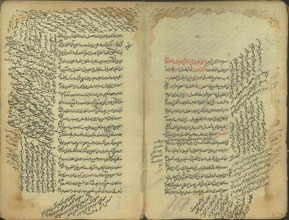Legenda and Bibliography
Last update 01 March 2017

Beginning of Ilāhiyyāt
Ms. Tehran, Kitābḫānah-i Maǧlis-i Shūrā-yi Millī (now: Kitābḫānah-i Maǧlis-i Shūrā-yi Islāmī = Parliament Library), 930
Sigla, Formulae, Abbreviations:
m = Manṭiq (= logic) of the Šifāʾ.
ṭ = Ṭabīʿiyyāt (= natural philosophy) of the Šifāʾ.
r = Riyāḍiyyāt (= mathematics) of the Šifāʾ.
i = Ilāhiyyāt (= metaphysics) of the Šifāʾ.
(m, ṭ, r, i) = ms. containing all the Šifāʾ (i.e. Manṭiq/logic, Ṭabīʿiyyāt/natural philosophy, Riyāḍiyyāt/mathematics, and Ilāhiyyāt/metaphysics).
(m, ṭ, i) = ms. containing Manṭiq, Ṭabīʿiyyāt, and Ilāhiyyāt,
(m, i) = ms. containing Manṭiq and Ilāhiyyāt.
(ṭ, i) = ms. containing Ṭabīʿiyyāt and Ilāhiyyāt.
Within Manṭiq, Ṭabīʿiyyāt, and Riyāḍiyyāt, the sections (funūn) are designed by lower-case Roman numerals (i, ii, iii, etc.) written as deponents (ex. gr.: mv = section five of Manṭiq/logic; ṭii-viii = sections ii-viii of Ṭabīʿiyyāt/natural philosophy; ri-ii, iv = sections i, ii, and iv of Riyāḍiyyāt/mathematics).
The four sections of Riyāḍiyyāt/mathematics are, respectively, on geometry, astronomy, arithmetic, and music.
Within Manṭiq, Ṭabīʿiyyāt, Riyāḍiyyāt, and Ilāhiyyāt, the treatises (maqālāt) and chapters (fuṣūl) are designed respectively by upper-case Roman numerals (I, II, III, etc.) and Arabic numerals (1, 2, 3, etc.) (ex. gr.:iI.1-3 = chapters 1-3 of treatise I of Ilāhiyyāt; ṭi.I.1-2 = chapters 1-2 of treatise I of section i of Ṭabīʿiyyāt/natural philosophy).
(+ Adwiya Qalbiyya2-9) = it contains chapters 2-9 of Avicenna's Adwiya Qalbiyya in ṭvi
(A) = ms. recorded in G. C. Anawati, Essai de bibliographie avicennienne, Dār Al-Maʿārif, Cairo 1950.
(B1) = ms. recorded in C. Brockelmann, Geschichte der Arabischen Litteratur, vols I-II, Brill, Leiden, 1898-1902; 1943-19492 (vol. I, p. 592).
(B2) = ms. recorded in C. Brockelmann, Geschichte der Arabischen Litteratur, suppl. vols I-III, Brill, Leiden 1937-1942 (suppl. vol. I, p. 815).
(D) = ms. recorded in Fihristvārah-i Dastnivišthā-yi Īrān (Dinā), The Abridged Catalogue of Iran Manuscripts, ed. M. Dirāyatī, Kitābḫānah, Mūzih va Markaz-i Asnād-i Maǧlis-i Šūrā-yi Islāmī, vol. VI, Tehran 1389Hš/2010.
(E1) = ms. recorded in O. Ergin, “Ibni Sina Bibliografyasi”, in Büyük Türk Filozof ve Tıb Üstadı Ibn Sina Şahsiyeti ve Eserleri Hakkında Tetkikler, İstanbul 1937, pp. 3-80.
(E2) = ms. recorded in O. Ergin, Ibn-i Sina Bibliografyasi, Yalçın Matbaası, Istanbul 1956.
(F) = ms. recorded in Fihristgān: nusḫahʾhā-yi ḫaṭṭī-i Īrān (Fanḫā), Union Catalog of Iranian Manuscripts, ed. M. Dirāyatī, Sāzmān-i Asnād va Kitābḫānah-i Millī-i Ǧumhūrī-i Islāmī-i Īrān, vol. XXI, Tehran 1390Hš/2011.
(M) = ms. recorded in Y. Mahdavī, Fihrist-i nusḫahā-yi muṣannafāt-i Ibn-i Sīnā, Intišārāt-i Dānišgāh-yi Tihrān, Tehran 1333Hš/1954.
(own.) = owner (instead of copyist; in the Copyists/Owners section)
(+ own.) = copyist and owner (in the Copyists/Owners section)
Styles:
bold = ms. used in Cairo ed. of the Ilāhiyyāt.
[italics within square brackets] = manuscript, or date of copying, or copyist attested.
Conventions:
A date of copying in which the year is precisely indicated (ex. gr.: 1071H/1660) is usually taken from the ms. itself (colophon or other). A more generic date (for instance: VII/XIII c.) is a conjectural date taken from bibliography (catalogues or specific studies) or provided by us on the basis of our insepction of the format, handwriting, and decoration of the ms. (in which case it is indicated by *). Dates in the Hiǧri calendar have been converted into the corresponding dates in the Gregorian calendar by using the following web-site http://www.dossier.net/utilities/calendar-converter/index.html.
Further Bibliography:
A. Q. Ahmed, “The Shifāʾ in India I: Reflections on the Evidence of the Manuscripts”, Oriens, 40, 2012, pp. 199–222.
I. ʿA. ʿArshī, Catalogue of the Arabic Manuscripts in Raza Library Rampur, Volume IV: Holy Scriptures, Logic & Philosophy, Printed for Raza Library Trust, Rampur, U.P. India 1971
A. Bertolacci, “How Many Recensions of Avicenna’s Kitāb al-Šifāʾ?”, Oriens, 40.2, 2012, pp. 275-303.
S. Brentjes, "Courtly Patronage of the Ancient Sciences in Post-Classical Islamic Societies", Al-Qantara, 39, 2008, pp. 403-36.
H. Daiber, “New Manuscript Findings from Indian Libraries”, Manuscripts of the Middle East, 1, 1986, pp. 26-48.
D. Gutas, “The Heritage of Avicenna: The Golden Age of Arabic Philosophy, 1000-ca. 1350”, in Avicenna and His Heritage. Proceedings of the International Colloquium “Avicenna and his Heritage”, Leuven-Louvain-la-Neuve, 8-11 September 1999, ed. J. Jannsens and D. De Smet, Leuven University Press, Leuven 2002, pp. 81-97.
D. Gutas, Avicenna and the Aristotelian Tradition. Introduction to Reading Avicenna’s Philosophical Works, Second Revised and Enlarged Edition, Including an Inventory of Avicenna’s Authentic Works, Brill, Leiden-Boston 2014.
S. al-Ḥīmī, “Manuscripts of Avicennian Works in the National Library al-Ẓāhiriyya”, Al-Turāṯ al-ʿarabī, 2, 1981, pp. 91-112.
K. Hirschler, Medieval Damascus. Plurality and Diversity in an Arabic library. The Ashrafiya library Catalogue, Edinburgh University Press, Edinburgh 2016, p. 27.
M. C. Kaya, İlâhiyyât-i Ṣifâ Ibn Sînâ, Vakıflar Genel Müdürlügü Yayınları, Publications of General Directorate of Foundations, Ankara 2005 (facsimile edition of ms. Turkey, Tire [İzmir], Tire Vakıf Necip Paşa Kütüphanesi, 446, with Turkish and English introduction on Avicenna's life, works, philosophy, and influence).
J. Lameer, “Towards a New Edition of Avicenna’s Kitāb al-Ishārāt wa-l-tanbīhāt”, Journal of Islamic Manuscripts, 4, 2013, pp. 199–248.
S. de Laugier de Beaurecueil, Manuscrits d’Afghanistan (Publ. de l'Inst. Fr. d'Arch. Or. du Caire T. XXVI), Le Caire, 1964.
B. Liebrenz, "An Arabic Letter (ca. AH 6th/12th CE c.) Concerning the Production of a Manuscript of Ibn Sīnā's al-Šifāʿ", Journal of Islamic Manuscripts, 9, 2018, pp. 32-38.
C. Martini Bonadeo, ʿAbd al-Laṭīf al-Baġdādī’s Philosophical Journey. From Aristotle’s Metaphysics to the ‘Metaphysical Science’, Brill, Leiden-Boston 2013.
R. Massani, "Āṯār Abū ʿAlī Sīnā dar Kitābḫānahāy ḫuṣūṣī wa-ʿumūmī Hind", in Le Livre du Millénaire d'Avicenne, vol. II, Tehran 1384Hš/1953, pp. 438-448 (English summary, ibid., vol. IV, pp. 184-6).
R. Pourjavady, Philosophy in Early Safavid Iran. Najm al-Dīn Maḥmūd al-Nayrīzī and His Writings, Brill, Leiden-Boston 2011.
D. C. Reisman, "Mahdavi Supplement. Šifāʾ Manuscripts", Handout distributed at the International Conference “The Manuscript Tradition of Avicenna’s Kitab al-Shifa’: The Current State of Research and Future Prospects”, Scuola Normale Superiore, Pisa, 22-24 September 2010.
S. H. Rizvi, “Mīr Dāmād in India: Islamic Philosophical Traditions and the Problem of Creation”, Journal of the American Oriental Society, 131, 2011, pp. 9-23.
R. Şeşen, Muḫtārāt min al-Maḫṭūṭāt al-ʿArabiyya al-nādira fī Maktabāt Turkiye, İslâm Tarih, Sanat ve Kültürünü Araştirma Vakfi (İSAR), Istanbul 1997, pp. 85-97.
ʿA. Ṭabāṭabāyī Yazdī, “Some Manuscripts from the Treasures of the Library Amīr al-Muʾminīn, on the Basis of the Catalogue of Muḥaqqiq Ṭabāṭabāyī” [in Persian], in Amīn-e Šarīʿat, Bunyād Muḥaqqiq Ṭabāṭabāyī 1391Hš/2012, pp. 174-250.
J. J. Witkam, “Avicenna’s Copyists at Work: Codicological Features of the Two Leiden Manuscripts of the Kitāb al-Shifāʾ”, Oriens, 40, 2012, pp. 223–55.
World Survey of Islamic Manuscripts, ed. G. Roper, 4 vols, Al-Furqan Islamic Heritage Foundation, London 1992-1994.
Philosophy on the Border of Civilizations and Intellectual Endeavours:
Towards a Critical Edition of the Metaphysics (Ilâhiyyât of Kitâb al-Šifâʾ) of Avicenna (Ibn Sînâ)
ERC Advanced Grant 339621
Scuola Normale Superiore, Pisa, Italy
Piazza dei Cavalieri, n. 7
IMT School for Advanced Studies, Lucca, Italy
Piazza S. Ponziano, n. 6
Mail: info@avicennaproject.eu



